Occupational Safety and Health
Basic Policy
ISK’s safety and health policy is to ensure the safety, security, and health of employees and local residents by complying with safety and health-related laws, preventing accidents and disasters, building a pleasant work environment, and constantly raising the level of safety and health. Additionally, we have established “occupational safety and health, operation safety, and disaster prevention” as one of our Group’s key issues (materiality) and are promoting initiatives aimed at achieving a lost injury frequency rate and severity rate of zero.
Safety and Health Management Structures
In line with our “Basic Policies on Environmental Protection and Safety & Health Promotion,” we have established the Environment, Safety & Health Management Committee under the purview of the Office of President to deliberate on the highest level policy proposals relating to safety and health, the environment and chemical substance management. Below this is the Safety and Health Council which, in addition to the organizations that promote environmental conservation and undertake chemical substance management, promotes occupational safety and health promotion awareness.
*You can see the entire image in the figure by scrolling horizontally.
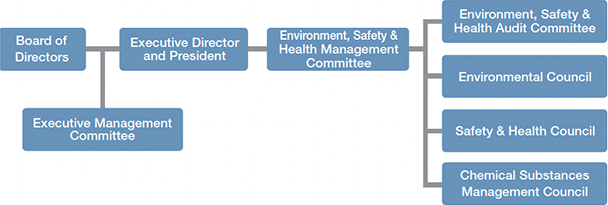
Safety and Health Management System
At ISK, we have established “president-directed environmental, safety and health goals” which reflect the characteristics of operation at each business location, and, in order to achieve these goals, key initiatives are set at the beginning of each fiscal year.
For the progress of activities related to the important initiatives, we ascertain the overall status of the plant, discuss countermeasures, and review measures as needed at monthly Safety and Health Committee meetings.
In addition, departmental and plant-wide reviews are conducted at the end of each fiscal year; activity summaries for each are created and provided to each other, including ISK Group companies, at the Safety & Health Council; information is shared and issues are sorted out; and then those issues are escalated to the Environment, Safety & Health Management Committee for deliberation. After reflecting on the initiatives of the current fiscal year, the Environment, Safety & Health Management Committee sets goals for the next fiscal year, and new initiatives are planned at each business location; thus a PDCA cycle is implemented to foster an upward spiral in occupational safety and health and health promotion awareness.
Occupational Safety and Health Initiatives
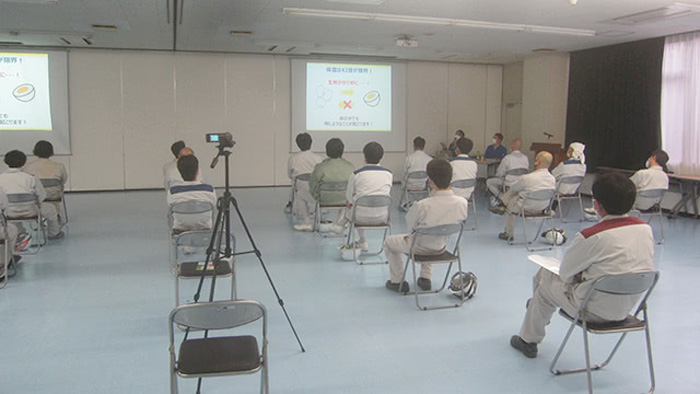 “CNRIA” wearable device for preventing heatstroke
“CNRIA” wearable device for preventing heatstrokeHeatstroke Prevention
As the heatwaves become more intense, we are taking basic steps to prevent heatstroke, such as by improving the working environment, managing the physical condition of workers, and managing working hours. In order to ensure product quality, some work is done indoors, which may result in high temperatures and humidity. In order to more effectively prevent heatstroke, we conducted a trial run of a heatstroke prevention wearable device* last year and are now fully introducing it this year as an additional measure against heatstroke.
*It is worn on the wrist like a watch and prevents heatstroke by detecting an increase in core body temperature (heat buildup) and then sounding an alarm.
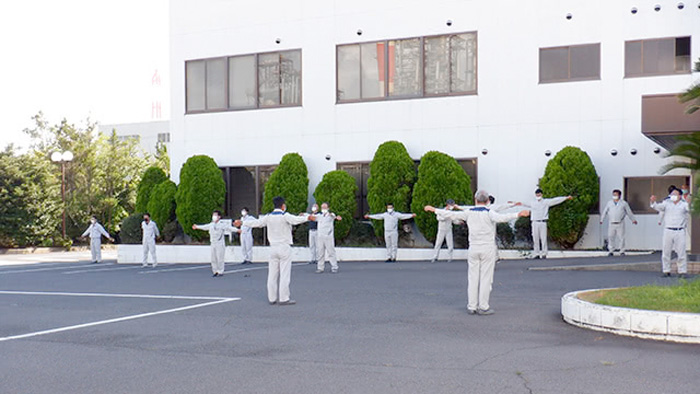 Morning calisthenics
Morning calisthenicsDaily Calisthenics
It’s not known exactly when ISK began holding daily calisthenics, but it has for sure been held every day before work since the 1950s. Daily exercise helps prevent injuries and are important in alerting employees to their physical condition on that day. Daily calisthenics are also believed to maintain good health. With average employee age increasing, calisthenics are growing in importance and ISK will continue to hold them in earnest.
Safety and Accident Prevention Initiatives
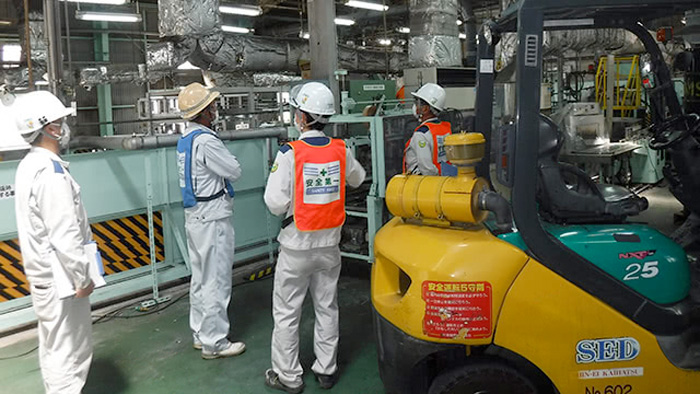 A safety patrol
A safety patrolSafety control is the foundation of ISK’s business. At the Yokkaichi Plant, our target is to eliminate fires, explosions, and any kinds of leaks. We conduct risk assessments with What-If Scenario Analysis: when installing new equipment or upgrading existing ones, when updating production methods, and when doing safety assessments of existing equipment where high-risk items such as hazardous substances and high-pressure gas are handled.
Then, countermeasures are taken for the extracted potential risks. We also focus on accident case study education, and company executives conduct periodic safety patrols.
Earthquake and tsunami evacuation drills to prepare for a megathrust earthquake are held annually for all personnel and vehicles using the Yokkaichi Plant. This improves our ability to respond quickly and appropriately to such emergencies.
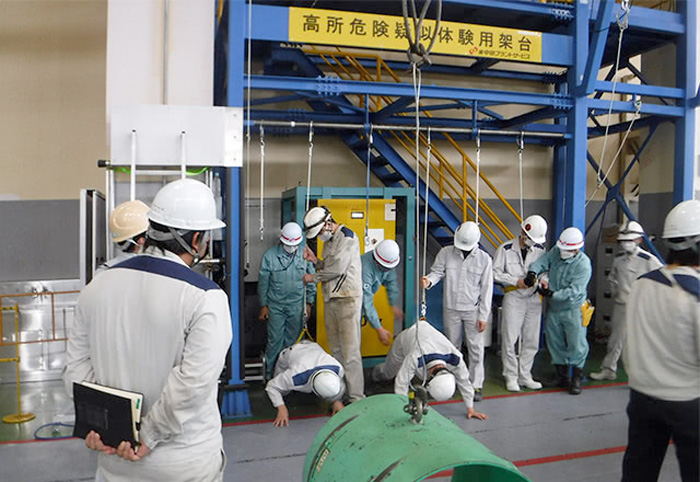 Practice hanging by a safety belt
Practice hanging by a safety beltHazard Simulation Classes for New Employees and Mid-Career Hires
In 2019, we added hands-on training to our classroom-centered health and safety training for new employees and mid-career hires. Using model equipment so employees can experience risks such as being exposed to liquids when operating valves, the training gives all participants firsthand experience in on-site dangers.
ISK also sends groups of employees to take danger simulation seminars at outside training facilities, where they do things like practice hanging in mid-air with safety belts and experience a simulated accident of getting pinched by or caught in equipment. This heightens their awareness of precaution and teaches them to avoid dangers in their actual work.
Safety and Disaster Preparedness Initiatives
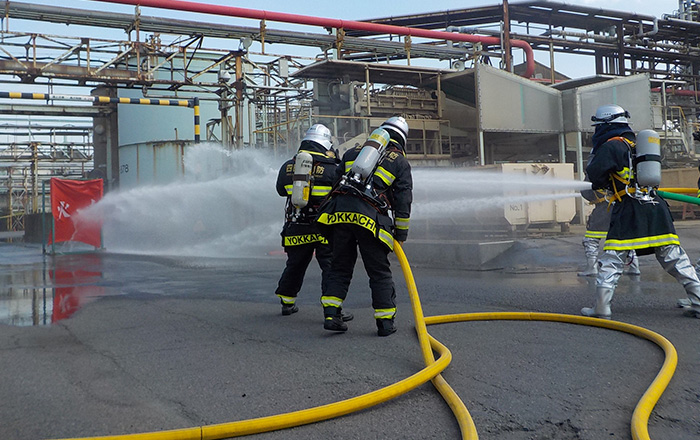 Joint drill by ISK’s Self Disaster Team and the local fire department
Joint drill by ISK’s Self Disaster Team and the local fire departmentYokkaichi Plant
In preparation for emergencies, Yokkaichi Plant conducts annual joint drills with the plant’s Self Disaster Team and the local fire department, which are open to the local residents.
In fiscal 2020 and 2021, due to the impact of COVID-19, we cancelled the joint training with the fire department and the public was, and conducted emergency drills in-house only. But in fiscal 2022, for the first time in three years, we restarted joint drills with the local fire department. We work to improve our level of disaster preparedness each year by adding new elements (such as the use of drones) to the drills.
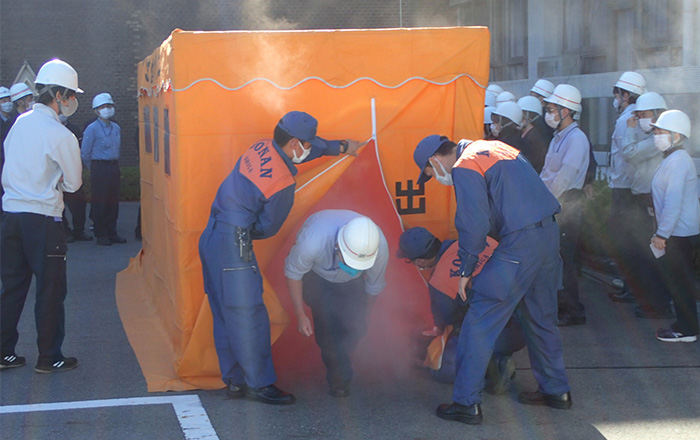 Earthquake experience using an earthquake simulation vehicle
Earthquake experience using an earthquake simulation vehicleCentral Research Institute
Comprehensive disaster drills are held for all personnel every year in the fall with the aim of raising awareness of disaster preparedness. In fiscal 2023, we conducted evacuation drills simulating an earthquake, and, with the cooperation of the fire department, who brought an earthquake simulation vehicle that allowed employees to experience the strong shaking that accompanies a powerful earthquake, provided comprehensive instruction in earthquake-related physical and mental preparations. Additionally, in March, firefighting training was held for our Self Disaster Team. This training was a review of all the actions that should be taken in the unlikely event of a fire and included training on calling 119 and how to spray water using outdoor fire hydrants. As a result of these efforts, we were commended by the Shiga Prefectural Fire Prevention and Safety Association as a Shiga Prefecture Fire Prevention and Safety Outstanding Business for fiscal year 2024 and were honored with a Governor's Award. We will continue to work to raise awareness about disaster prevention so that we can serve as a role model for the local community.
